Many high-ranking AI apps feel like an attempted cash grab, and it’s not easy to spot the trash from the treasure.
Generative AI has been one of the most buzzworthy tech trends of 2024, and app developers have been quick to ride the wave. The Apple App Store is teeming with AI-powered tools, with “AI” now a staple feature across top apps in categories like education, productivity, and photo editing. For many developers, particularly in graphics and design, the boom has created a golden opportunity to cash in.
But while the quantity of AI apps is staggering, the quality often leaves much to be desired. Beneath the glossy App Store listings and lofty promises, a significant portion of these tools fail to deliver. Many prioritize monetization over functionality, hiding key features behind paywalls, exaggerating their capabilities, or in some cases, barely functioning at all.
I tested some of the most popular AI apps on the App Store to get a clearer picture of the space—and the results were eye-opening. While some apps make genuine attempts to deliver value, many seem designed to capitalize on hype, leaving users disappointed and out of pocket.
AI Dominates the Graphics and Design Category
If you browse the top 10 graphics and design apps on the App Store, it’s impossible to miss the AI trend. Around half of the current leaders in this category explicitly include “AI” in their names. Notably, three of these are products from the same developer: HUBX, a company founded in Turkey in 2022.
HUBX’s apps, including DaVinci AI, Home AI, and Tattoo AI, have secured high rankings despite their lackluster performance. DaVinci AI, for instance, is marketed as a versatile AI image generator and photo editor. But beyond its enticing name, the app offers very little. Most features are locked behind a subscription that costs $30 annually or $5 weekly, and the free trial only provides access to a rudimentary text-to-image generator using unspecified versions of Stable Diffusion and DALL-E.

The generated images are low-quality, often poorly cropped or resized, and riddled with errors. In-app advertisements pop up at every turn, and the clunky user interface makes navigation frustrating. Even worse, users who pay for the premium version can’t download their edited images without an intrusive watermark.
Yet, DaVinci AI outperforms established names like Microsoft Designer in the rankings, with only Adobe Express managing to stay ahead in the graphics and design category.
The issues aren’t limited to DaVinci AI. Home AI, marketed as an interior design assistant, produces hilariously inaccurate renderings of rooms, while Tattoo AI, another HUBX offering, often fails to function entirely. Both apps share the same subscription model and relentless review prompts as DaVinci AI. Even the update notes on their App Store pages are copy-pasted and devoid of any meaningful details.

Despite accumulating a suspiciously high number of five-star reviews, HUBX’s apps are met with scathing criticism on social media and in the App Store’s comment sections. Common complaints include poor customer service and false advertising. HUBX, unsurprisingly, did not respond to my requests for comment.
The Rising Popularity of AI Apps
The allure of AI features is undeniable. According to Sensor Tower, four out of the top 10 most downloaded graphics and design apps in the U.S. this year include “AI” in their name. While this is a slight drop from last year, the top-performing apps are experiencing explosive growth. For example, Photoroom, an AI-powered photo editing app, has seen its downloads skyrocket by over 160% since last year. Meanwhile, established platforms like Photoshop Express, which also includes generative AI tools, have seen a 21% decline in downloads.
But not all AI apps are created equal. While many fail to live up to their promises, a handful of tools are genuinely pushing the boundaries of what AI can do for creatives.
The Good: Apps That Deliver
Amid the sea of underwhelming offerings, a few apps stand out for their practical and well-executed features.
Photoroom and Picsart AI, for example, are all-in-one graphic design platforms that blend AI-powered editing tools with traditional templates and digital assets. Both apps rank highly in the App Store’s “Photo and Video” category and offer features like automatic background and object removal. While their AI tools aren’t groundbreaking—background removal lags behind Canva, and object removal isn’t as seamless as Google Magic Editor—they work as advertised.
Both apps also have transparent pricing models. A $13 monthly subscription unlocks their premium features, which is on par with competitors like Canva ($15/month) and Adobe Express ($10/month).
These apps may not revolutionize the creative process, but they demonstrate that AI can enhance productivity without overpromising or underdelivering.


A Tale of Two Platforms: iPhone vs. iPad
Interestingly, the AI app craze is far more prominent on iPhones than iPads. The top 100 iPad apps feature a diverse mix of graphic design tools, including Adobe Fresco, Clip Studio Paint, and Canva, with very few AI-focused apps making the cut.
This disparity suggests that AI apps primarily appeal to casual users looking for quick, cost-effective solutions rather than professional creatives. Photographers, illustrators, and designers seem to prefer sticking with established tools that prioritize precision and control over flashy AI features.

The Dark Side of AI’s Popularity
The rapid rise of AI apps mirrors trends seen in mobile gaming, where developers exploit the “free” label to attract users before hitting them with in-app purchases. Many AI apps use similar tactics, marketing themselves as free but locking almost all meaningful functionality behind subscriptions or pay-per-use models.
This bait-and-switch strategy erodes trust and makes it harder for genuinely useful apps to stand out. As users wade through a glut of subpar offerings, they risk overlooking tools that truly add value.
The Future of AI on the App Store
The AI gold rush on the App Store shows no signs of slowing down, but the market’s saturation may force developers to innovate—or fail. As we head into 2025, the challenge will be separating the wheat from the chaff.
For now, consumers should approach AI apps with caution. Look for tools that clearly outline their features, deliver on their promises, and offer transparent pricing. With so many apps chasing trends, the ones that succeed will be those that put users first.
Generative AI has the potential to revolutionize creativity, but only if developers treat it as more than just a buzzword. Let’s hope the next wave of apps raises the bar.










